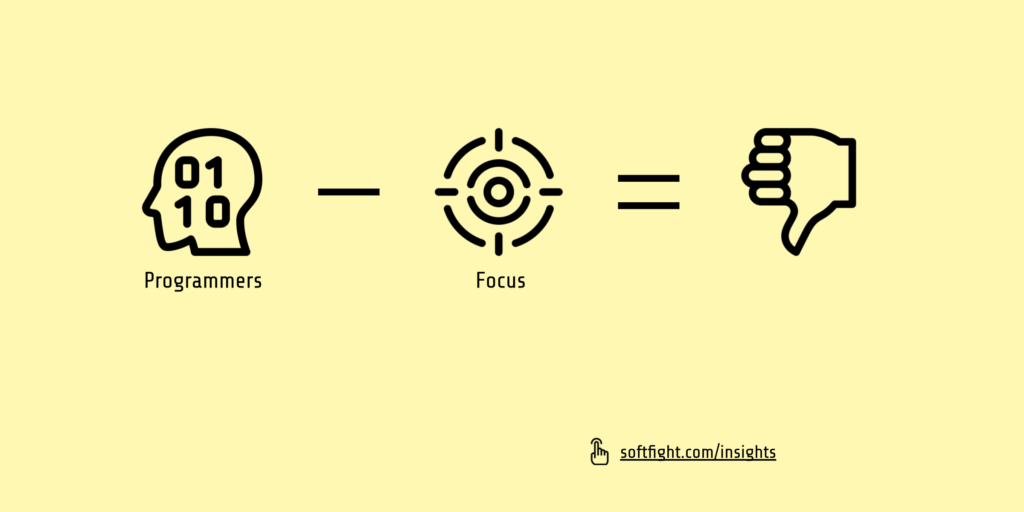There is no easier way to get a blank stare from a software services manager than to ask: “So, what is your company’s focus? Who are your core customer segments?”

Eventually, you might get an answer along the lines of
- “Our expertise is X development, and we like to keep our options open by working with both startups, Fortune500 and any other company size in between. We would prefer to do agile projects, but a lot of times the client is not on board with that, so we adapt.”
What about the industries you work with?
- “Oh, yes, we are great at this. We can work with clients from any industry. We’ve done projects with banks, healthcare multinationals, we’ve developed apps for marketing startups and we’ve also worked on a web-based e-commerce platform.”
The common perception among entrepreneurs and managers is that the bigger you want your company to grow, the more diverse your services offering should be and the more types of projects, clients and industries you should be able to serve.
This might make sense if you are running a company with 5.000 employees, spread around the globe.
But this thinking has trickled down the line to companies with 10 employees, whose owners believe they should make a proposal for any potential lead they can find, regardless of the technology stack required or the prospect’s industry.
You can look at this as a classical chicken and egg problem.
Do you become bigger because you are diversified, or do you diversify because you have grown bigger?
The answer is: none of these.
You diversify because you are afraid.
You are afraid of saying no.
The questions I hear might be:
- What if we say we are specialised in Java Development and then we get a lead for a mobile apps project with ING Bank? Are we supposed to say no to that?
- What if we decide to focus on working with Financial Services clients and then find an opportunity to develop an e-commerce platform? How can we not do that?
- What if we spend 1 year training everyone in our team to do at least a decent level of “agile” and then we get an RFQ from an automotive manufacturer who demands that suppliers have PRINCE2 certified project managers allocated to the project? Are we supposed to pass on that?
The straight answer to all these questions is generally yes.
You are supposed to say no to all these, at least 90% of the time, if they are not your core competencies.
When you choose a focus for your company, you are saying yes to a narrowly defined set of variables that describe your potential customers.
And you are saying no to everything else.
These variables are:
- Industry
- Company Size
- Type of Project
- Type of Process
- Geography
- Technology Stack
- Deployment Model (cloud, on-premise or hybrid)
- Type of Buyer (Business or Technical)
- Role or Profile of the Main Project Owner
At the intersection of 2 or 3 of these criteria you will find your core customer segments.
Here is an example:
We specialise in providing Software Development Services for Financial Services companies in Europe.
This might look like a very narrow positioning, but I would argue it’s still way too broad.
Does it mean that you will work both with small fintech startups that need a basic iOS mobile app to raise money from angel investors and with Deutsche Bank to work on some core banking system with Java?
Can you run 2 projects with 2 different customers, one with agile, 2 weeks sprints, and the other one a 2 year, waterfall-based project?
Does your definition of Software Development include UX? Does it matter to you if the customer is a startup looking to build an innovative UX on mobile or if they just want to pay for a Bootstrap-like internal, web-based tool.
Does it make any difference for you if the Main Project Owner on the customer side is an experienced Technical Product Manager or is the Lead Developer of their internal development team?
What about language skills and boots on the ground in different countries? Can you do a project with a client in Germany? Finland? Spain? Poland? They are all in Europe, so they are all within the scope of the segment we defined above.
As you can see, the customer segment(s) you choose to focus on will have a direct, significant impact on everything you do in your company.
It determines what type of employees you need to recruit and how to train and develop them.
It informs your go-to-market strategy: what you communicate, on which channels, for which audience.
It changes the way you organize your sales and contracting process.
And, crucially, it has an impact on your pricing: what you are charging for, at what price and how you present that to each prospective customer.
So let’s rephrase the chicken and egg problem. The dilemma is not between size and diversification.
It’s between specialisation and price levels you can charge.
The cheaper your services are, the less you need to specialise. You can sell anything to anyone – because quality doesn’t matter that much.
The more you want to charge*, the more you have to specialise and choose a narrow focus, so that you can sell and deliver the quality required by the higher prices.
And which came first? Higher prices or narrow focus?
It doesn’t matter. I’ve seen both work as well.
You can start with lower prices and gradually specialise as you gain experience. Then increase your prices as the quality of your service grows.
Or you can start with high prices in a specialised, niche market, use the high margins to hire experts, so you can deliver the high quality required by those high prices.
* or the more you HAVE to charge, because your costs (aka salaries) have gone through the roof
What this means for you
If you want a simple, 3-items type of framework to think about this, here is one.
A software services company has to choose one from any of these:
- An Industry Vertical
- A Technology Stack
- A Type of Delivery Process
That’s it.
Choose one specialisation in one of these areas, and that’s your narrow focus.
It doesn’t have to be more complicated than that.

